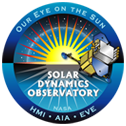About the Sun Lab
We all know that the Sun keeps us warm, helps plants grow, and provides us energy. But did you know that the Sun is an ever-changing, dynamic sphere of hot gas that can have drastic and long-lasting effects here on Earth?
Solar storms and space weather can emit strong electrical currents that could disrupt our communication and electrical systems for weeks, months, or even years. That’s one reason scientists have begun using powerful solar telescopes to observe the Sun and find ways to predict these storms. Now, in NOVA’s Sun Lab, you can do it too.

Solar storms can be observed by powerful solar telescopes.
From NASA's Helioviewer
The Sun Lab includes a powerful solar observation tool created by NASA called the Helioviewer, which pulls in real time data from an array of instruments including the Solar Dyamics Observatory (SDO) and the Solar and Heliospheric Observatory. The Sun emits light in a range of colors but because yellow is the brightest that’s all we see with the naked eye. The specialized instruments at these observatories allow us to “see” all the different colors of light and get a more complete, accurate understanding of what’s happening on the Sun’s surface and in its surrounding atmosphere.

Zoom and pan around the Sun with the Helioviewer tool.
From NOVA's "Sun Lab"
In the Sun Lab, We’ve created two guided research activities to show you how to use the Helioviewer to gather and analyze data from the Sun. You can then apply these skills in an investigation of your own.
Sun Lab activities include:
Solar Cycle
Counting sunspots is one of the simplest and most reliable ways to estimate the level of solar activity. In this challenge, you’ll study images of the Sun to estimate the number of sunspots in a region and then compare your number to the official count by NASA researchers. Once you’ve learned how to count sunspots you can learn how to classify them in Storm Prediction.
Storm Prediction
Characteristics such as size, complexity, and motion can be used to predict a sunspot region’s future behavior. In a series of challenges, you’ll compare pairs of solar images to try to determine which region is more likely to produce a solar storm in the near future. After each challenge, you’ll see a video of what actually happened in those regions.
Open Investigation
After you’ve learned how to count and classify sunspots, you can begin your own investigations using the Helioviewer. Select different solar observatories, instruments, and light wavelength channels to see what’s happening in different layers of the Sun. You can access live data, select a date in the past, or compare the data over time.

Image from the "Anatomy of the Sun" video
From NOVA's Sun Lab
Videos
The Sun Lab also includes ten short videos about Sun basics, space weather, and solar research technology. These videos will give you a broad understanding of the Sun and why it’s important to study it. These videos can be viewed in the Sun Lab Video Quizzes or in our NOVA Labs Video Library.
Want to learn more about the Sun Lab? You can watch the Sun Lab Introduction Video or jump right in and begin the Sun Lab.


